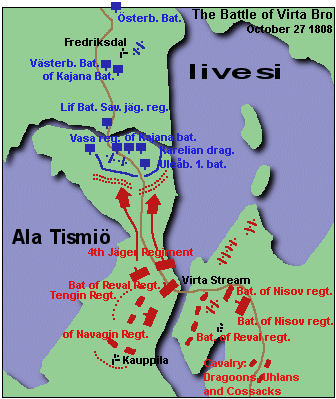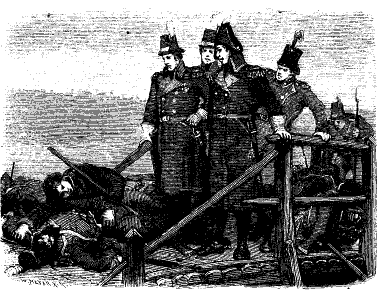The battle of Virta Bro
 October 27 1808, R=Nikolai Alexejvitsch Tutschkoff S=Johan August Sandels
October 27 1808, R=Nikolai Alexejvitsch Tutschkoff S=Johan August Sandels
During the late summer of 1808, the Swedish positions in Finland were under serious pressure. In September Adlercreutz with the main Swedish army lost the decisive battle of Oravais, forcing him into retreat north. In the east, Johan August Sandels had been defending the Toivala-front for three months, against almost daily Russian attacks and advances. Now, however, as the main army in the west was defeated, the lines of communication were threatened and Sandels saw himself forced to pull back north, not to end up in a Russian trap. On top of this, the Russians on the Toivala-front were now being strengthened with reinforcements from Russia. Prince Dolgorukij arrived with fresh forces and the strength of the two opposing armies soon stood one to four. Sandels found Perfect defensive positions at Virta Bro (north of Idensalmi) and therefore retreated north, leaving the Russians to occupy the Toivala position. On september 29, the cease-fire of Lochteå was signed, leading to a pause in the war.
On October 27 the cease-fire ended and the Russians saw their chance at driving Sandels out once and for all. "Sandels was the best of the against us acting generals", it was said among the Russians. The Russians had 6.000 first-class troops at their disposal at Virta Bro, the Swedish had only 1.800 with 12 guns. But the Swedes had their military genius among them - Sandels.
At midday, the Russian attack began and large numbers of troops poured over the bridge, attacking the Swedish positions on the other side. Four battalions of the Reval, Tengin and Navagin regiments were forced over the bridge by Prince Dolgorukij, who commanded the assault. Sandels calmly pulled back to the redoubts and defences just north of the bridge, knowing that the Russian troops would not follow in an instant, because of the greater firepower of the Swedish artillery there. And here he awaited the main Russian attack, as it took some time for them to reorganize. Sandels had prepared a trap.
At the given signal, and when the first Russians reached the defences, the Swedish troops went over on counter attack with bayonets on (bayonets was the only language the Russian soldiers would understand, it was said.). An intense battle followed, in which the Swedish went forth and pushed the Russian troops back towards the bridge. An enormous disorder developed in the Russian lines as they reached the bridge and tried to get over. The Swedish pulled forward two guns and let them play with bloody effect against the routed Russians. Soon the Russian Nisov and Navagin regiments appeared on the other side of the river and a lively exchange of fire followed for about an hour. But the Russians had been beaten.
Russian losses counted at 764 dead and wounded; 74 prisoners of war were taken. The Swedes are reported to have lost 312 men, of which 18 were officers. As an example, the Vasa regiment lost 20% of its strength. Sandels had won an enormous tactical victory; in fact this battle was the last major Swedish military victory on Finnish soil. "Gentlemen, this has been our Austerlitz", Sandels said.

Back to Battles
© Göran Frilund 2000-03, All Rights Reserved.
If you've surfed onto this page from outside and there is no menu on the left,
CLICK HERE for the full Website.

 October 27 1808, R=Nikolai Alexejvitsch Tutschkoff S=Johan August Sandels
October 27 1808, R=Nikolai Alexejvitsch Tutschkoff S=Johan August Sandels